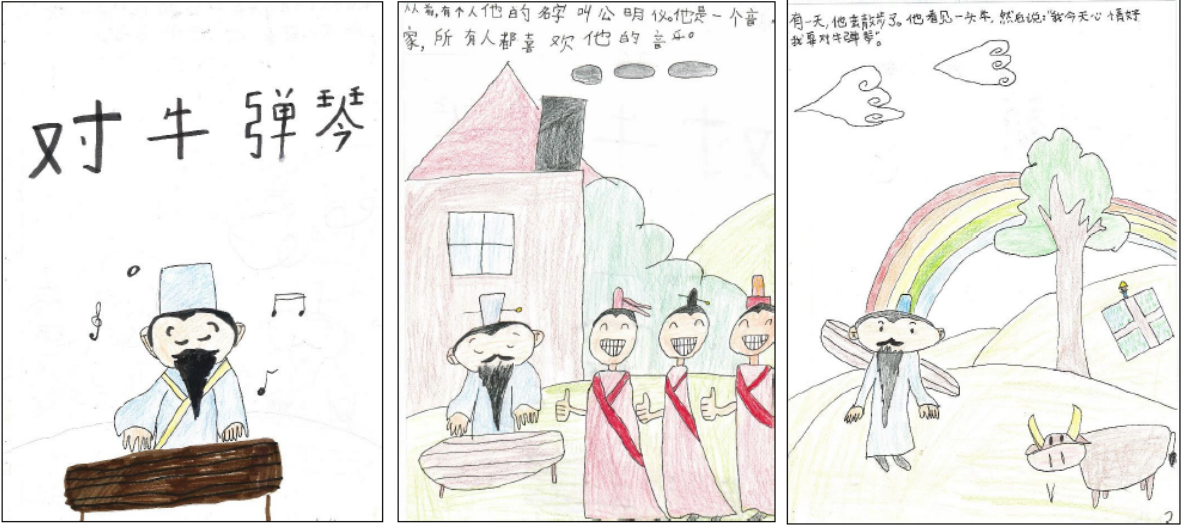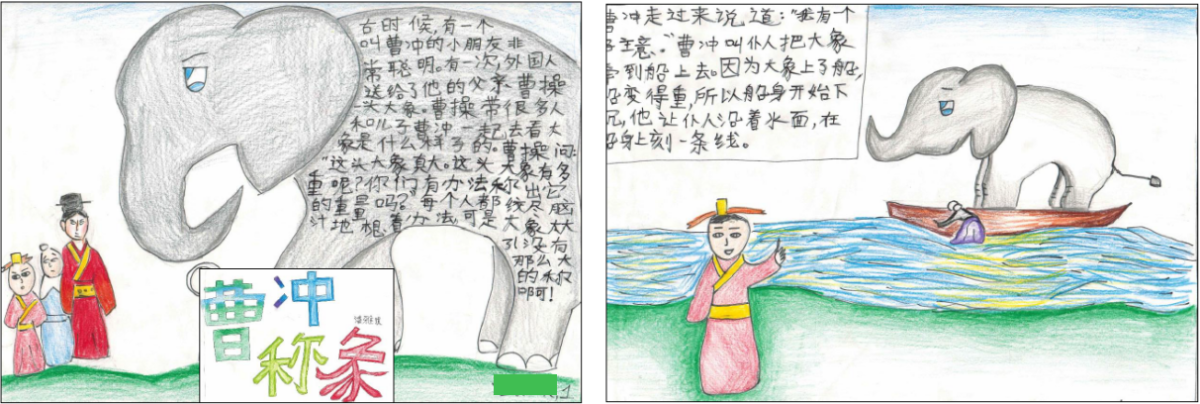

In our Chinese summer camp in 2023, we adopted “Chinese Idiom Stories” as the theme. However, for overseas children, Chinese idioms are difficult to understand, remember, read, and write. These idioms seem like “mysterious scripts from space”, intimidating children and hindering their progress in learning Chinese. As overseas Chinese language educators, what should we do?
We used creative teaching methods to enhance children’s interest in learning Chinese language through drawing and idiomatic storytelling. Creative teaching is a positive educational approach that breaks free from the constrains of traditional teaching methods, emphasizing the stimulation of children’s imagination and creativity. In our summer camp, after learning about an idiom, children expressed their understanding through drawing and text, creating their own “idiom graphic novels.” During the process of creating these drawings, children’s comprehension, imagination, and creativity were fully utilized as they boldly expressed their self-awareness and ideas through their artwork. They unleashed their boundless imagination and creativity, tirelessly producing “idiom graphic novels,” creating their own world, perceiving Chinese culture, enjoying learning Chinese, and gaining confidence in their knowledge of Chinese culture.
We compiled the students’ “idiom graphic novels” into a book, including six of the most commonly used and well-known idiomatic stories: “Lord Ye Loves Dragon” (叶公好龙), “Mend the Pen After Sheep Lost” (亡羊补牢), “A Fox Borrows Tiger’s Might” (狐假虎威), “Playing Music to the Cow” (对牛弹琴), The Tortoise and the Rabbit Race” (龟兔赛跑), and “Cao Chong Weights the Elephant” (曹冲称象). We hope that, through the teaching format of drawing, we can break the bottleneck of idiom learning in the Chinese language education for overseas primary and secondary school students. We then open a door to infinite possibilities for Chinese language learning and inject new vitality into Children’s Chinese language learning. We aim to let more primary and secondary school students learn, understand, master, and apply idioms, thereby enjoy the fun and benefits of learning Chinese language and culture, and play a solid foundation for mastering Chinese language and culture holistically.
我们2023年的中文夏令营选择“中国成语故事” 作为夏令营的主题。但是,对于海外的孩子们,汉语成语难懂、难记、难读、难写,这些成语如同“天书”一样,令孩子们发怵,望成语而止步,久而久之,成语学习成了汉语学习的瓶颈。作为海外汉语教育工作者,我们应该怎么办呢?
我们尝试着用创意教学法,通过绘画和成语故事情节提高孩子们的汉语学习兴趣。创意教学是一种积极向上的教育方法,它突破了传统教学模式的束缚,注重激发学生的想象力和创造力。我们夏令营的孩子们在学完一个成语之后,根据自己对这个成语的理解,用图画和文字的形式表达出来,绘制自己的“成语画册”。在图画创作过程中,孩子的理解力、想象力、创造力得到充分的发挥,将一种自我意识和想法大胆地通过他们所创作的图画表现出来。孩子们开启天马行空的想象力和创造力,乐此不疲地画出一本本“成语画册”,画出了自己的一片天地,画出了对中华文化的感知,画出了学汉语的乐趣,画出了对中国文化知识的自信。
我们把孩子们的“成语画册”汇编成一本集锦,包括一年级到八年级的孩子的“作品”,6个最常用、脍炙人口的成语故事:叶公好龙、亡羊补牢、狐假虎威、对牛弹琴、龟兔赛跑和曹冲称象。我们希望通过绘画的教学形式拓宽海外中小学生的汉语教学中成语教学的瓶颈,为中文学习开启一扇通向无限可能性的大门,为孩子们的中文学习注入新的活力。让更多的学汉语的中小学生走近成语、学习成语、了解成语、掌握成语、应用成语,从而享受学习汉语和中国文化的乐趣和益处,为全面掌握汉语打下坚实的基础。
“Lord Ye Loves Dragon” (叶公好龙) by a 2nd Grader

“Mend the Pen After Sheep Lost” (亡羊补牢) by a 3rd Grader


“A Fox Borrows Tiger’s Might” (狐假虎威) by a 4th Grader

“Playing Music to the Cow” (对牛弹琴) by a 5th Grader


The Tortoise and the Rabbit Race” (龟兔赛跑) by a 7th Grader


“Cao Chong Weights the Elephant” (曹冲称象) by an 8th Grader





